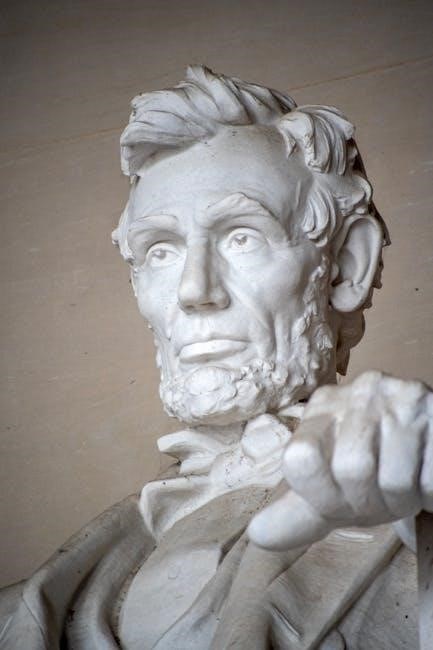A Washington quitclaim deed is a legal document used to transfer property interest without guarantees, often utilized for simplicity in specific transactions like family transfers or divorce cases.

Definition and Purpose of a Quitclaim Deed
A quitclaim deed transfers property interest without guarantees, offering a simple way to convey rights, often used in family transfers or divorce settlements to avoid disputes.
2.1. What is a Quitclaim Deed?
A quitclaim deed is a legal document that transfers a grantor’s interest in real property to a grantee without guarantees or warranties. It conveys only the rights, title, or interest the grantor has at the time of transfer, making it simpler than a warranty deed. This type of deed is often used in non-market transactions, such as transfers between family members or in divorce settlements. It does not provide assurances about the property’s title, liens, or encumbrances, making it less protective for the grantee. Despite its limitations, a quitclaim deed is legally binding and notarized, ensuring the grantor’s relinquishment of any claim to the property. It is frequently used to resolve ownership disputes or transfer property in cases where a clear title is already established.

2.2. Purpose and Common Uses
The primary purpose of a quitclaim deed is to transfer property interest without providing guarantees about the title’s validity. It is commonly used in informal transactions, such as transferring property between family members, settling estates, or in divorce proceedings where one spouse relinquishes property rights. Additionally, quitclaim deeds are utilized to clear title issues, resolve ownership disputes, or transfer property with unknown or problematic title histories. They are also used when a property is gifted or sold between parties who trust each other, eliminating the need for extensive title searches. This simplicity makes quitclaim deeds a practical solution for specific, often personal, real estate transactions in Washington State.

Legal Requirements for a Valid Quitclaim Deed in Washington State
A valid quitclaim deed must be properly executed, notarized, and adhere to Washington State’s legal and formatting requirements, ensuring the grantor’s signature is acknowledged by a notary.

3.1. Execution and Notarization
For a quitclaim deed to be legally binding in Washington State, it must be properly executed. The grantor (seller) must sign the deed in the presence of a notary public, who acknowledges the signature. This step ensures the authenticity of the grantor’s consent and verifies their identity. The notary’s acknowledgment is a critical legal requirement, as it confirms that the grantor voluntarily executed the deed. Without proper execution and notarization, the deed may not be recognized as valid. The notary will stamp or seal the document, completing the execution process. This step is essential for ensuring the deed’s enforceability and adherence to state laws.
3.2. Formatting and Content Requirements
A Washington quitclaim deed must adhere to specific formatting and content requirements to ensure validity. The document must include a cover sheet for recording purposes, with a top margin of at least three inches and a bottom margin of one inch. It should clearly state the grantor’s and grantee’s names, addresses, and the legal description of the property. The deed must also include the tax parcel number, the effective date, and a statement conveying the grantor’s interest. The language should align with Washington State laws, particularly RCW 64.04.050, which provides the acceptable form and content for quitclaim deeds. Proper formatting ensures the document is accepted for recording and meets all legal standards.

The Process of Preparing and Recording a Quitclaim Deed
Preparing a Quitclaim Deed involves gathering property details, completing the form accurately, and recording it with the County Recorder’s Office in Washington.
4.1. Gathering Necessary Information
To prepare a Quitclaim Deed, gather essential details such as the property description, including its legal description and tax parcel number. Identify the names and addresses of both the Grantor (seller) and Grantee (buyer). Determine the consideration exchanged, which may be monetary or non-monetary. Ensure the property is located in the correct county for recording purposes. Verify the grantor’s ownership rights and check for any liens or encumbrances. Additionally, prepare a cover sheet for recording, as required by Washington State law. Accurate information is crucial to avoid delays or legal issues during the recording process.
4.2. Filling Out the Form Accurately
When completing a Washington Quitclaim Deed, ensure all fields are filled accurately. Include the Grantor’s and Grantee’s full names and addresses. Provide the property’s legal description, including the tax parcel number, and specify the county where the property is located. Detail the consideration (monetary or otherwise) exchanged for the transfer. Sign the deed in the presence of a notary public, who will acknowledge the signature. Ensure the document adheres to Washington State formatting requirements, such as proper margins and spacing. Avoid errors, as inaccuracies can delay recording or invalidate the deed. Double-check all information before submission to the county recorder’s office.
4.3. Recording the Deed
Once the Quitclaim Deed is properly executed, it must be recorded with the County Recorder’s Office in the county where the property is located. Submit the original notarized deed along with any required cover sheets and fees. The recording process ensures the transfer is publicly documented, providing legal notice of the property’s change in ownership. The Recorder’s Office will stamp the deed with the recording date and return a copy to the grantee. Ensure all formatting and content meet Washington State requirements, including proper margins and page size, to avoid delays. Timely recording is essential for validating the transfer and protecting the grantee’s rights.
Key Considerations When Using a Quitclaim Deed
Quitclaim deeds offer no guarantees, making them risky for disputed titles. They are best for transfers between trusted parties, like family members or in divorce cases, but legal advice is recommended to avoid potential issues.
5;1. Risks and Limitations
A quitclaim deed lacks guarantees, meaning the grantor may not actually own the property or may transfer incomplete rights. This leaves the grantee vulnerable to hidden liens, disputes, or claims from other parties. Unlike a warranty deed, it offers no protection against defects in the title, making it riskier for the buyer. Additionally, the grantor’s liability for the property’s condition or taxes may persist, potentially leading to legal disputes. While useful for simple, low-risk transactions, quitclaim deeds are not ideal for purchases involving unrelated parties or complex ownership situations. Consulting a legal expert is crucial to navigate these limitations and ensure the transfer’s validity.
5.2. When to Use a Quitclaim Deed
A quitclaim deed is ideal for transferring property in specific situations, such as transferring ownership between family members, resolving divorce property settlements, or adding/remove someone from a title. It is commonly used when the grantor wants to relinquish their interest without guarantees. This deed is suitable for non-monetary transfers, like gifting property or resolving ownership disputes. However, it is not recommended for real estate purchases involving unrelated parties, as it lacks protections for the buyer. Using a quitclaim deed ensures a quick and straightforward process for low-risk, intra-family, or clear-title transfers. Always ensure proper notarization and recording to validate the transaction. Consulting a legal expert is advised to confirm its appropriateness for your specific situation.
5.3. Tax Implications
The tax implications of a quitclaim deed in Washington State depend on the nature of the transaction. If the property is gifted, the grantor may face gift tax if the value exceeds the annual exclusion limit. For sales, capital gains tax may apply if the property has appreciated. The grantee’s tax basis typically equals the property’s fair market value at the time of transfer, impacting future capital gains calculations. Inheritance transfers may qualify for a stepped-up tax basis, reducing future tax liabilities. It’s important to consult a tax professional to understand the specific implications, as Washington State law treats real estate transactions uniquely. Proper documentation and reporting ensure compliance with state and federal tax regulations.
Consequences of Transferring Property via Quitclaim Deed
Transferring property via a quitclaim deed in Washington State has specific consequences. The grantor relinquishes all ownership rights and claims to the property, and the grantee assumes full responsibility. Unlike a warranty deed, the grantor does not guarantee the title’s validity, leaving the grantee vulnerable to undisclosed liens or encumbrances. If the property has outstanding debts or legal issues, the grantor may still be liable. The transfer can also affect property taxes, as the grantee becomes responsible for future payments. Additionally, the grantor may face tax implications if the transfer is considered a gift or sale. It’s crucial to understand these consequences before executing the deed, as they can significantly impact both parties involved. Proper legal advice is recommended to navigate these potential risks.
Quitclaim Deed vs. Warranty Deed
A quitclaim deed and a warranty deed differ significantly in the guarantees they provide. A warranty deed ensures the grantor has clear ownership and protects the grantee from future claims or defects in the title. In contrast, a quitclaim deed only transfers the grantor’s current interest without any guarantees, leaving the grantee responsible for resolving any issues. Warranty deeds are commonly used in real estate purchases, offering the buyer more protection. Quitclaim deeds are typically used for non-market transactions, such as transferring property between family members or in divorce settlements. While a warranty deed provides assurance, a quitclaim deed is simpler and often used for specific, uncontested transfers. Understanding these differences is essential for choosing the right deed for a property transaction in Washington State.

Finding and Downloading the Washington Quitclaim Deed PDF
To obtain a Washington quitclaim deed, you can download the form in PDF or Word format from reputable legal websites or official county resources. Websites like LegalTemplates.net or local county recorder offices provide free templates that meet state requirements. Ensure the form is specific to Washington State and includes all necessary sections, such as grantor and grantee details, property description, and notarization areas. Before downloading, verify the source for accuracy and compliance with current laws. Once downloaded, carefully review the form to ensure it aligns with your needs. Always follow the instructions provided with the template to complete and record the deed properly. This ensures the document is legally valid and accepted by county recorders.
Common Mistakes to Avoid
When preparing a Washington quitclaim deed, several common mistakes can lead to legal or recording issues. One major error is providing an incorrect property description, which can result in disputes or invalidation of the deed. Another mistake is failing to have the document notarized, as this is a legal requirement for validity in Washington State. Additionally, omitting or misspelling the grantor’s or grantee’s name can cause delays or rejection by county recorders. Failing to include the tax parcel number or legal description of the property is also a frequent oversight. Furthermore, not adhering to formatting requirements, such as margin sizes or font styles, can prevent the deed from being recorded. Lastly, using an outdated or incorrect form for Washington State can render the document invalid. Always ensure accuracy and compliance with state laws to avoid these pitfalls.

Best Practices for Executing a Quitclaim Deed
To ensure the Washington quitclaim deed is executed correctly, always use the most recent form from official sources to avoid outdated templates. Properly notarize the document, as this is a legal requirement for validity in Washington State. Ensure all grantor and grantee information, including names and addresses, is accurately filled out. Include the correct legal description and tax parcel number of the property to prevent delays. Double-check the deed for any errors before recording. Use black ink to sign and ensure the grantor’s signature is acknowledged by a notary public. Submit the deed with the required fee and cover sheet to the appropriate county recorder’s office. For complex situations, consider consulting a legal professional to avoid potential issues. Timely recording ensures the transfer is officially recognized.
A Washington State quitclaim deed is a straightforward yet powerful tool for transferring property interest without guarantees. It is commonly used in situations like family transfers, divorce proceedings, or clearing title issues. While it offers simplicity, it’s crucial to understand its limitations, such as the lack of title warranties. Proper execution, including notarization and accurate completion of the form, is essential for legality. Consulting a legal professional is recommended for complex cases to avoid potential pitfalls. By following best practices and adhering to state requirements, individuals can effectively use a quitclaim deed to transfer property in Washington State. Always ensure timely recording to finalize the process and validate the transaction.
